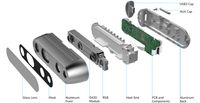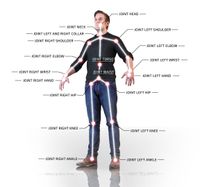MARKERLESS MOTION TRACKING
Markerless motion caption with a single camera is a promising approach for skeleton tracking. Nowadays, used within video gaming it is a possible system for clinical gait analysis. This project aims to assess the reliability and validity of an Intel® RealSenseTM camera compared to a reference system for gait analysis in running sports. Inertial Measurement Units were used as the reference standard and a Python script based on the Nuitrack SDK was implemented to process the optical data.
As part of a feasibility study, seven healthy participants were tracked with both systems during walking and jogging indoors and outdoors. The knee, hip, shoulder, and elbow angles were tracked simultaneously and processed to be statistically analyzed.
Although the optical system was able to track skeletons in outdoor and indoor settings, the results of the outdoor settings were too poor to be analyzed. The indoor measurement results found a moderate ability of the optical system to approximately match the knee, shoulder, and elbow angles measured with the reference system. The hip angles generated the highest errors and the lowest correlation. In conclusion, the Intel® RealSenseTM camera and Nuitrack SDK are not yet reliable and valid tools for gait analysis in clinical settings and need improvement hardware- and software-wise.
Used Hardware
Depth cameraD430 with maximum frame rate of90 fps
IR projector projects static IR pattern
2 imagers detect the reflected IR pattern
IMUs MYON aktos
Reference standard
Used Software
Matches the camera and tracks skeletons
Using NuitrackSDK Trial Licence
Up to 6 different skeletons with 19 joints
EMG Motion Tools Software from Cometa srl
Used for the IMUs
Implementation using Python
The following angles were calculated by establishing several vectors taking the tracked coordinates and using the dot product: shoulder angle α, right hip H, right shoulder S and right elbow E. All angles were then stored as CSV files. The recorded videos, RGB and depth, were displayed and stored as single frames as PNG.
Experimental Setup
Indoor setting:
One laptop equipped with the EMG Motion Tools Software connected to the MYON Aktos Reciever.
Walking path marked 2.2m in front of the camera.



